Combine capacity boost – buy, hire or contractor?

Upping combine capacity is one way of coping if we have a repeat of the near-disastrous weather we’ve seen for the past two summers. But what’s the best way to do it? Nick Fone looks at the options for buying second-hand, hiring, or using a contractor.
After two successive summers that will go down as harvests to forget, many farmers are looking at ways of boosting combine capacity as a means of outwitting the weatherman.
For larger growers with big, shiny machines that are regularly replaced, hopping up a rung on the harvester ladder isn’t too much of a drama. Often it’s just a matter of softening up the bank manager or finance agent with coffee and biscuits and then hitting them with a water-tight financial case that they can’t argue against.
But for smaller farmers it’s a different story. Having a combine capable of cutting 1500 acres on a 500-acre farm is an expensive luxury. But at least it is one route to ensuring that crops are gathered at their driest.
Hiring
Many might be looking at buying but combine hire specialist APH (Agricultural Plant Hire) has some cautionary advice. Not surprisingly, the firm recommends looking closely into renting a combine for the summer, but also suggests that the right contractor with the right kit can still be a good, reliable option.
“Over 400-600 acres is the most you can justify spending on a combine is £40,000 to £60,000,” says hire and sales manager Martin Powell.
“But there just aren’t the medium-sized five-walker machines out there. For that money, you can end up with a high-output harvester, but it will have clocked up about 3000 hours, so reliability becomes an issue.”
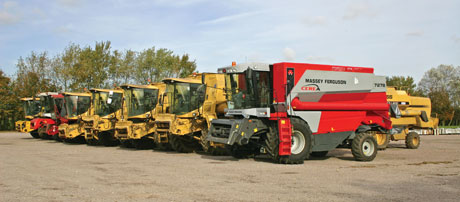
A big second-hand combine may help to speed up harvest, but won’t necessarily guarantee reliability. Consider hiring one or using a contractor to fix your harvest costs.
The reason for the shortage of middleweight combines is partly down to exchange rates, he says. “We’ve seen a 20% shift in currency over the past 18 months. So European buyers have been coming over by the bus-load and buying everything that moves.
“It’s simple supply and demand, which drives up prices on the home market.” This, along with the reliability issues of running high-hour harvesters, can make the cost of ownership unpredictable. Renting is one way around that issue.
“Generally, hiring a combine will cost the same as owning one,” says Mr Powell. “But with hire it’s a known fixed cost. If there’s a breakdown it’s our responsibility to get it sorted, so the headache’s taken out of the job.”
APH offers three rental options:
• Fully maintained – everything is covered – £50-74/ha (£20-30/acre).
• Harvestcare – all main components (engine, hydraulics, gearboxes, etc) are covered – £37-62/ha (£15-25/acre).
• Hire only – farmer is responsible for all breakdowns – £30-50/ha (£12-20/acre) (figures are based on a combine cutting 400-600 acres a year).
Harvestcare is the most popular, with many operators prepared to sort out minor breakdowns themselves. More than half of the enquiries the company receives are from farmers with less than 240ha (600 acres) to cut. These customers are often advised to consider teaming up with a neighbour to spread the cost of the hire or think about part-season rental. For example, winter barley growers on the east coast of Norfolk may start harvest in mid-July and finish by late August. In such a case, APH has the opportunity to shift that combine on to cut later crops for another customer further north. Both farmers then pay a reduced hire charge.
| Combine options – the pros and cons | ||
| Buy | Hire | Contractor |
| Hold control of harvest | Wait in line for combine | |
| Run combine to match grain handling capacity | Infrastructure at store to handle high combine output? | |
| Could end up cheapest if strong residuals | Not vulnerable to machinery market fluctuations | No capital outlay |
| Unpredictable cost | Fixed cost | |
| £54-64/ha (£22-26/acre) | £45-54/ha (£18-22/acre) | £77-86/ha (£31-35/acre) |
| * Figures based on a combine cutting 200ha (500 acres a year). Ownership costs allow £8000-9000 a year for depreciation/interest and £3000-4000 a year for repairs/maintenance. | ||
Second-hand selection
If hiring isn’t your thing and contractors are out the window because you want control of your own harvest, then now is the time to start looking for second-hand options. To get an idea of what you get for your money, here’s a selection from the second-hand lists of APH and fellow Cambridgeshire combine dealer Kevin Kirby.
New Holland TX68-PLUS
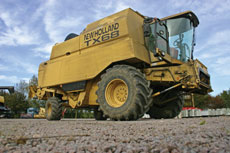
1999, 2400 engine hours, good condition
What you get 24ft header, six straw walkers, 325hp engine, chopper and chaff spreader
Plus points Self-levelling sieves, auto-height header, readily available parts supply, good residual values
Sum-up Well-respected, reliable straw-walker machine
Price tag £45,000-50,000
Claas Lexion 480
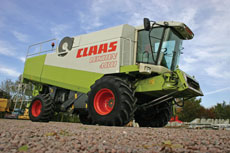
1999, 2500 engine hours, good condition
What you get 25ft header, hybrid drum and concave/twin rotor threshing, 400hp engine, chopper and chaff spreader
Plus points Self-levelling sieves, yield monitor, auto-height header, strong residuals, good dealer back-up
Sum-up High output but can be hard on straw
Price tag £50,000-55,000
Massey Ferguson Cerea 7278
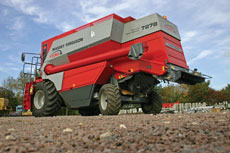
2000, 2200 engine hours, immaculate condition
What you get 25ft header, eight straw walkers, 387hp engine, chopper and chaff spreader
Plus points Belt-fed PowerFlow header with additional anti-wrap auger, auto-height header, yield and moisture meters
Sum-up High-output and gentle on straw
Price tag £45,000-50,000
[Pic on CD in MF 7278 folder – MF1.jpg or MF 2.jpg]
John Deere 2258
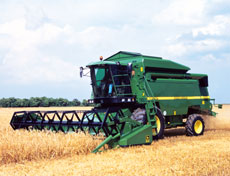
1998, 1800 engine hours, good condition
What you get 18ft header, five straw walkers, 250hp engine, chopper and chaff spreader
Plus points Auto-height headers
Sum-up Basic straw-walker combine
Price tag £40,000-45,000
[Pic to come from Isabel]
Case IH Axial Flow 2366
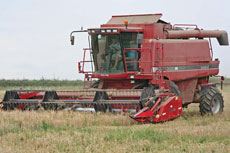
1999, 2400 engine hours, reasonable condition
What you get 16ft header, single rotor threshing, 240hp engine, chopper
Plus points Auto-height header
Sum-up Simple straightforward rotary combine, can be heavy on straw
Price tag £40,000-45,000
[Pic on CD in Case folder – Axial Flow 2366.jpg]
New Holland TF78
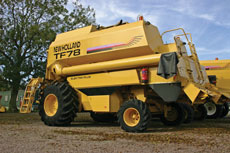
2000, 2500 engine hours, good condition
What you get 30ft header, hybrid drum and concave/single rotor threshing, 360hp engine, chopper and chaff spreader
Plus points Self-levelling sieves, auto-height header, yield and moisture meters
Sum-up High-output hybrid, can be hard on straw
Price tag £43,000-45,000
Claas Lexion 450
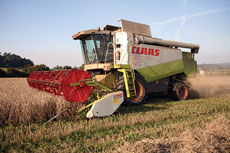
1999, 2400 engine hours, reasonable condition
What you get 25ft header, six straw walkers, 275hp engine, chopper and chaff spreader
Plus points Self-levelling sieves, yield monitor, auto-height header, strong residuals, good dealer back-up
Sum-up Well-respected, reliable combine, gentle on straw
Price tag £48,000-50,000
10 Tips for buying second-hand
APH sales engineer Kevin Butter gives some advice on what to look out for when looking for a used combine.
1 Overall appearance
The general condition of the machine will give the best indication as to how well it’s been looked after. As an example, check the main drive belts for cracks and signs of wear. If they haven’t been changed, that will indicate maintenance hasn’t been thorough.
2 Drum and concave
Inspect the concave for any obvious damage, such as broken wires or bent ribs – this will tell you if the machine has swallowed something it shouldn’t have and could mean trouble through the threshing system. Rasp-bar teeth worn below 6mm will have a detrimental effect of threshing efficiency so factor in £450 for a new set or up to £1000 for a new drum.
3 Engine
Check there is no oily scum or emulsion in the coolant. Start engine and check the breather pipe. If it is smoking it could indicate worn piston rings as a result of it being run with a blocked filter. APH recommends retro-fitting a finer secondary air-filter to older combines to avoid such damage.
4 Threshing gear
Set the combine mechanism going and walk around it listening for anything untoward. Dodgy bearings or worn belts should be easy to pick up.
5 Straw chopper
Look out for cracks around the chopper mountings on the rear hood. Their presence usually indicates that the rotor has been run out of balance. This is often caused by wear in the blade brushes so check and replace them before taking the rotor off to be rebalanced. A new set of blades could cost anything between £400 and £1000, but they will pay for themselves in fuel savings.
6 Tyres
Inspect the tyre sidewalls for bulges and cracks. When run under-inflated, air can get down between the laminate layers and cause bubbling. This can be sorted by fitting tubes. But expect to pay up to £1500 for new front-end rubber.
7 Electrics
Go through all the controls and check that everything works. Often electrical faults can be down to poor contacts or bad earths rather than component failure. Buy a can of electrical cleaner and use it on sensors, switchgear and connectors.
8 Straw walkers and sieves
Look out for wear where the walkers run alongside each other. This is usually caused by worn bearings on the cam-shaft, particularly where wooden block bearings are used, as on John Deere and Claas combines. If left too long, the shaft will also need replacing.
Check for cracks and welds on the sieves – repairs could be a sign of shaker-shoe bearing issues. It’ll take a fitter a day to replace them.
9 Header
Inspect the double-fingers for knife wear. Big gaps mean the knife won’t cut cleanly and can flex, which puts extra strain on the driveline and wobble-box.
10 Elevators
Check chain tension on the clean-grain and returns elevators. If they’ve been allowed to run slack they can damage the centre-plate and it’s an expensive job to replace it.
Second-hand specialists
Looking for second-hand combines? Try the following specialists:
- Kevin Kirby 01733 219 880
- APH 01733 840 691
- Combine World 0800 585 938
- Ian Houlgrave 01507 466 352
- Frank Taylor 01697 342 191
- www.fwmarketplace.co.uk
| What do you think the best option is? Buy a combine, hire one or get in a contractor? Share your thoughts on our forum |
|---|

